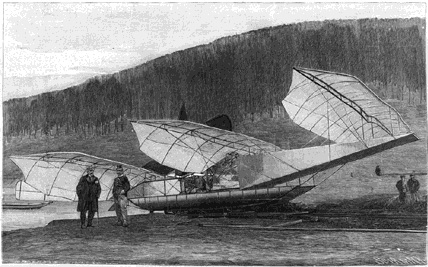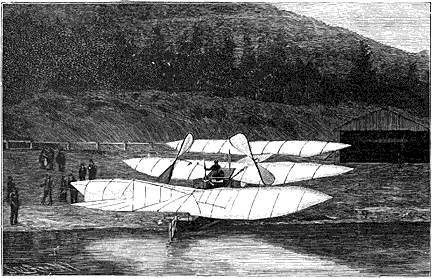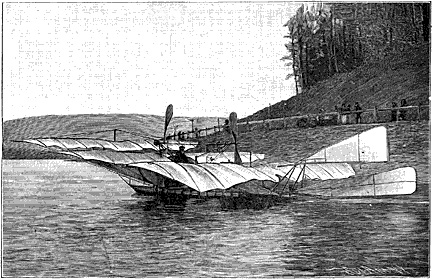

The most recent attempt to solve the problem of artificial flight has been made by W. Kress, a German engineer, who for twenty years has patiently labored on an aeroplane in which he has embodied his ideas.
The Kress aeroplane consists of an ice-boat having two keels and a long stem. The keels serve as runners when the machine is traveling over ice or snow. Two resilient sail-propellers, rotated by a benzin-motor in opposite directions, drive the apparatus. Above the boat, arched sails, constituting resistant kite surfaces, are carried, one sail being mounted somewhat above the other, so that it will receive an impinging body of air without interference from the other sails. The aeroplane thus constituted is guided by a horizontal and a vertical rudder, both of which, however, are used only in flying.

Owing to lack of funds the inventor could not equip his air-ship with a benzin-motor of the special construction and power desired, and was therefore compelled to use an ordinary automobile-motor. Thus fitted out the aeroplane was first tried on water. For it is Mr. Kress' opinion that water-trials should first be made in order to ascertain whether the motor, propellers, rudders, and other parts have been properly arranged and are trustworthy and perfectly efficient in operation. Only when the safety of the machine has thus been proven should aerial flights be taken. The sense of security obtained by numerous water-trials and the increased speed attained with each trial will finally give to the aeronaut that confidence which will enable him to soar aloft. That moment, according to Mr. Kress, may come unawares; the ship may of its own accord leave the surface of the water.

So far as the preliminary water-trials are concerned, the Kress aeroplane seems to have met its inventor's expectations. In the presence of an officer of the aeronautical division of the German army, the flying-machine was taken from its housing and carted to a nearby lake. Kress seated himself in the boat and pulled the starting lever. The propellers drove the machine along at a uniform speed, according to the accounts which have been received. In order to test the maneuvering power of the contrivance Kress is said to have performed various evolutions and to have succeeded even in making headway against the wind. The steering apparatus seems to have acted efficiently. The motor, however, proved inadequate. With a motor of less weight and greater horse power the inventor believes that his flying-machine would be an assured success. Lack of funds may prevent him from carrying out his plan with an improved motor.

Originally appeared in Scientific American, 84, March 2, 1901, p. 137
sbck/htgb
Back to the Inventor's Gallery